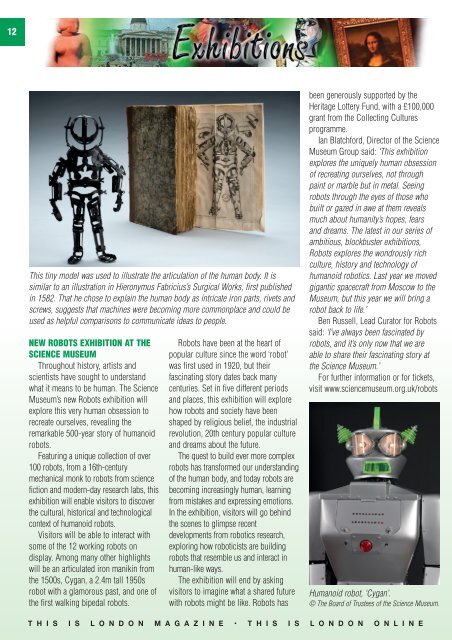172159_HiRes
You also want an ePaper? Increase the reach of your titles
YUMPU automatically turns print PDFs into web optimized ePapers that Google loves.
12<br />
This tiny model was used to illustrate the articulation of the human body. It is<br />
similar to an illustration in Hieronymus Fabricius’s Surgical Works, first published<br />
in 1582. That he chose to explain the human body as intricate iron parts, rivets and<br />
screws, suggests that machines were becoming more commonplace and could be<br />
used as helpful comparisons to communicate ideas to people.<br />
NEW ROBOTS EXHIBITION AT THE<br />
SCIENCE MUSEUM<br />
Throughout history, artists and<br />
scientists have sought to understand<br />
what it means to be human. The Science<br />
Museum’s new Robots exhibition will<br />
explore this very human obsession to<br />
recreate ourselves, revealing the<br />
remarkable 500-year story of humanoid<br />
robots.<br />
Featuring a unique collection of over<br />
100 robots, from a 16th-century<br />
mechanical monk to robots from science<br />
fiction and modern-day research labs, this<br />
exhibition will enable visitors to discover<br />
the cultural, historical and technological<br />
context of humanoid robots.<br />
Visitors will be able to interact with<br />
some of the 12 working robots on<br />
display. Among many other highlights<br />
will be an articulated iron manikin from<br />
the 1500s, Cygan, a 2.4m tall 1950s<br />
robot with a glamorous past, and one of<br />
the first walking bipedal robots.<br />
Robots have been at the heart of<br />
popular culture since the word ‘robot’<br />
was first used in 1920, but their<br />
fascinating story dates back many<br />
centuries. Set in five different periods<br />
and places, this exhibition will explore<br />
how robots and society have been<br />
shaped by religious belief, the industrial<br />
revolution, 20th century popular culture<br />
and dreams about the future.<br />
The quest to build ever more complex<br />
robots has transformed our understanding<br />
of the human body, and today robots are<br />
becoming increasingly human, learning<br />
from mistakes and expressing emotions.<br />
In the exhibition, visitors will go behind<br />
the scenes to glimpse recent<br />
developments from robotics research,<br />
exploring how roboticists are building<br />
robots that resemble us and interact in<br />
human-like ways.<br />
The exhibition will end by asking<br />
visitors to imagine what a shared future<br />
with robots might be like. Robots has<br />
been generously supported by the<br />
Heritage Lottery Fund, with a £100,000<br />
grant from the Collecting Cultures<br />
programme.<br />
Ian Blatchford, Director of the Science<br />
Museum Group said: ‘This exhibition<br />
explores the uniquely human obsession<br />
of recreating ourselves, not through<br />
paint or marble but in metal. Seeing<br />
robots through the eyes of those who<br />
built or gazed in awe at them reveals<br />
much about humanity’s hopes, fears<br />
and dreams. The latest in our series of<br />
ambitious, blockbuster exhibitions,<br />
Robots explores the wondrously rich<br />
culture, history and technology of<br />
humanoid robotics. Last year we moved<br />
gigantic spacecraft from Moscow to the<br />
Museum, but this year we will bring a<br />
robot back to life.’<br />
Ben Russell, Lead Curator for Robots<br />
said: ‘I’ve always been fascinated by<br />
robots, and it’s only now that we are<br />
able to share their fascinating story at<br />
the Science Museum.’<br />
For further information or for tickets,<br />
visit www.sciencemuseum.org.uk/robots<br />
Humanoid robot, ‘Cygan’.<br />
© The Board of Trustees of the Science Museum.<br />
t h i s i s l o n d o n m a g a z i n e • t h i s i s l o n d o n o n l i n e

















